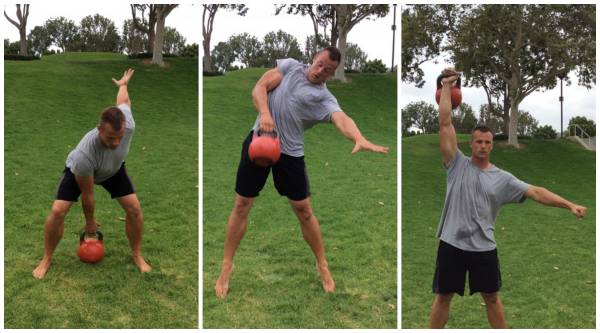I am sure many of you know how rewarding of an exercise the one-arm dead snatch is. Personally, it is my favorite exercise, and as a health professional for over ten years, I have both performed and taught thousands of snatches.
In this article, I am going to explore the one-arm dead snatch in fine detail. Combine smart technique with smart practice sessions and you will be blown away by how quickly you develop this movement.
Dead Snatch vs. Ballistic Snatch
The dead snatch can be performed with a kettlebell, dumbbell, or anything heavy. I’ve even used barbells by gripping the balancing point. In this article, I am going to use the dead snatch as the premise for our lesson, specifically with a kettlebell.
The kettlebell snatch can be performed either from dead or, more commonly, from a swing (a ballistic snatch). The snatch from dead does not utilize the elastic tension provided by the downward swing like a ballistic snatch. Therefore, the dead snatch requires a greater ability to deliver power from nothing. A ballistic snatch requires greater ability to absorb weight into your hips and also more hip flexibility to tame the arc of the bell as you reach hip extension. You may also find that the ballistic snatch requires more grip strength to reverse the course of the bell.
Either way, the snatch is an explosive lift from the ground or the base of a swing that accelerates the weight upward with the hips to the overhead loaded lat position. Both versions of the snatch, ballistic and dead, are an upward acceleration of weight, not a forward motion and not a jerking motion.
Precursors to the Snatch
Before even practicing and using the dead snatch in your workouts, you should have already mastered the deadlift and the overhead lockout position. Practicing kettlebell swings and clean and press can also help transition you to the snatch.
“This exercise uses a little bit of everything to make it happen right – focus, flexibility, strength, power, endurance, and courage.”
Another important precursor is the necessary mobility. Tightness in your shoulder that prevents you from locking your elbow and holding the weight in proper vertical alignment will prevent you from reaching your lifting potential. The most common reason people struggle to reach their potential with the snatch is because of tightness in the hip flexors and shoulders. One factor that makes me an advocate for the kettlebell snatch, as opposed to a dumbbell, is that the handle is usually higher off the ground, requiring less flexibility to perform.
Warming Up for a Snatch
Heavy deadlifts are great to warm up with before training power phase lifts. This is known as contrast training. Contrast training is the principle of lifting something extremely heavy with a certain muscle group to make a subsequent weight feel lighter. The heavy deadlift will make the kettlebell feel light in contrast, allowing you to transition from the strength phase to the power phase in the same muscle group with maximum capacity. If you have ever picked up a light object that you thought would be heavy and accidentally lifted it much higher or faster than intended, you have seen this work.
Perform short sets of incrementally heavier deadlifts without going to failure. You will recruit the same muscles that will accelerate the lighter load overhead when you transition to the snatch. Move directly from the deadlift to the snatch to help access all of your strength and reach your full potential.
Snatching the Kettlebell
To begin, you will need a hook grip on the bell. Make sure there aren’t any kinks in the chain from your shoulder to where your fingers wrap around the handle of the bell. In other words, make sure your shoulder isn’t forward, your elbow isn’t bent and your wrist isn’t flexed. Keep a straight line all the way down.
Also, keep your back flat. When you are at the base of your dead snatch, you can use your lower back muscles to arch your back and prevent rounding. The shorter your spinal erector muscles become in hip flexion, the greater degree of tension placed in the hamstring and glutes.
Before the moment of power, put upward tension on the bell handle. The actual lift will simply be a continual acceleration of this upward tension. The tension is important here because it will prevent the common mistake of trying to dip down right before lifting and yanking the bell off the ground. If you are unable to accelerate the weight properly and are attempting to yank it with all your might, you will not be able to lift to your potential.
“Always progress your training appropriately. There are many steps to take before you begin snatching weight.”
As you punch upward, the hook grip will turn into a spear-hand, into the handle of the bell. The kettlebell snatch can be compared to cracking a whip in the way you pull back and push upward. As you punch through the bell, it should meet the back of your wrist smoothly.
This point is where your experience with the clean and jerk will come in handy. The overhead loaded lat position should be automatic. But rarely do I see an individual who is able to properly find this position without looking for it. By the time you develop the snatch, you should be able to load the lat immediately when the bell reaches the top. Practice the clean and press until you get this down.
Common Mistakes When Snatching
- Dipping down at the moment of power, attempting to yank the weight off the ground, instead of accelerating it smoothly. Align your shoulder straight over the handle of the kettlebell. This will shift your body off to one side a little and move your shoulder back over the bell. In order to snatch to your potential, you need to keep that weight along the plumb line of your body the whole time.
- Shoulder not directly over the weight, but off to the side or out front. This is due to an excessive forward lean. Slightly lower your hips to minimize the forward lean and align your shoulder over the weight.
- Driving the bell out front (usually a result of mistake #2). As you reach full extension, pull the bell back with a slight shrug to keep the bell close to your body. As you reach hip extension, your hips should be forward at the moment of maximal power with a slight flexion of the spine.
- Arching the back at the point of hip extension. At the point of maximum power, you have accelerated the weight straight up your body, floating it to just above eye level. Your hips may end up slightly in front of the plumb line of your body, this is fine as long as your abs stay braced. Make sure that as your hips move in front of your body, your abdomen tightens to prevent the back from arching.
- Shoulder elevation at the overhead position. To prevent this sink your shoulder blade down and back. Exercises such as the clean and press can help you learn how to load the lat properly.

Loading and exploding with the hips along with a strong overhead position are the elements to a strong dead snatch.
Benefits of the Snatch
This exercise uses a little bit of everything to make it happen right – focus, flexibility, strength, power, endurance, and courage. The heavy one-arm snatch, the one so heavy that it uses every ounce of my potential, is as close to hitting a grand slam in the major league as a kettlebell practitioner will come. Snatches will also help you develop grip and upper back strength.
Safety When Snatching
Always progress your training appropriately. There are many steps to take before you begin snatching weight. Lifting anything overhead, especially while standing, should be practiced only by those who have followed the appropriate progressions to get there.
Strength and the Kettlebell Snatch
The kettlebell snatch is a great representation of strength, and as a long-time kettlebell practitioner, it remains one of my favorite exercises to perform. It challenges you both mentally and physically and brings many benefits. I hope you explore the heavy kettlebell snatch from dead to better improve your weightlifting capabilities.
Check out these related articles:
- Breaking Muscle Video: the Kettlebell Snatch
- How to Develop a Super Solid Kettlebell Snatch (Without the Dreaded Smack)
- The Kettlebell Snatch – A Swing That Ends Up Overhead
- What’s New On Breaking Muscle Today






